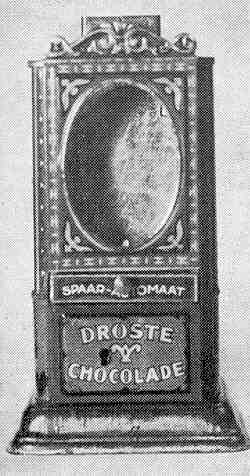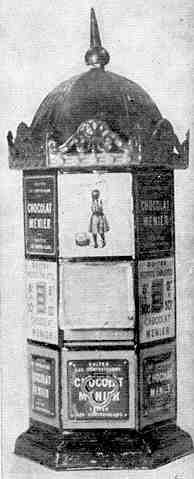Vending Banks, Part 1
by F.H. Griffith - HOBBIES Magazine - February 1976
 The period of 1910 into the 1930’s represents a time during
which a great number and variety of tin vending type mechanical banks were made. Some were
made in the States, a far greater number Abroad, and most of these in Germany. The action
and end result in all these vending type banks is practically the same — a coin is
dropped or inserted in a coin slot, the coin engages a release mechanism so that a drawer
or whatever may be pulled open and a wrapped piece of chocolate slides out. There’s
nothing very earth-shaking about the action involved, however, all banks of this type are
very definitely in the mechanical category and it is necessary to use a coin to receive
the piece of candy.
The period of 1910 into the 1930’s represents a time during
which a great number and variety of tin vending type mechanical banks were made. Some were
made in the States, a far greater number Abroad, and most of these in Germany. The action
and end result in all these vending type banks is practically the same — a coin is
dropped or inserted in a coin slot, the coin engages a release mechanism so that a drawer
or whatever may be pulled open and a wrapped piece of chocolate slides out. There’s
nothing very earth-shaking about the action involved, however, all banks of this type are
very definitely in the mechanical category and it is necessary to use a coin to receive
the piece of candy.
Key locking coin traps are provided in most of the vending banks. This may mean the entire back or side may swing open or slide up, not only to remove coins but also to replenish the stock of small chocolate bars. The bars are usually exposed to view from the front of these banks by means of a small glass window, tempting the viewer to place his coin and receive his candy.
A line of demarcation exists between toy vending machines per se and vending toy savings bank. A vending toy savings bank is just that — primarily a toy savings device in which to save money and in so doing a reward for each coin saved. The purpose, of course, to encourage a savings habit in a child. The savings encouragement of most mechanical banks is the visual action, and this is primary. In the case of vending banks, the action is secondary and the piece of candy primary.
 Not to confuse the issue, but rather to keep clarification, it
should be mentioned that not all the vending banks use small chocolate bars. There are
exceptions, and one that comes to mind at the moment is a toy tin bank that dispenses a
cigarette on insertion of the coin. This bank actually shows in colored lithography boys
smoking cigarettes! Very definitely, in the writer’s opinion, this bank was made in
the 1920’s during the carefree, careless attitude typical of this era.
Not to confuse the issue, but rather to keep clarification, it
should be mentioned that not all the vending banks use small chocolate bars. There are
exceptions, and one that comes to mind at the moment is a toy tin bank that dispenses a
cigarette on insertion of the coin. This bank actually shows in colored lithography boys
smoking cigarettes! Very definitely, in the writer’s opinion, this bank was made in
the 1920’s during the carefree, careless attitude typical of this era.
There is no doubt that the prime purpose behind the vending banks was to promote the chocolate candies of various well known companies. One of the largest, Stollwerck, utilized banks for various Countries so that some Stollwerck are in French and used a French coin; others in German and the respective coin; English for English coins; English for American coins, and so on. All with the purpose, of course, of promoting Stollwerck chocolate in each respective Country.
One of the more attractive of the vending type banks is the Droste’s Spaar-Automaat, Figure 1, and No. 256 in the numerical classification. It is lithographed in various decorative colors of red, gold, light and dark blue, brown, white and pink. A mother, father, son and daughter are lithographed on the left side and back. They are shown putting coins in the bank. The right side has the Droste figure with a chocolate bar. The picture speaks for itself, the action we have covered, and there’s not much more to be said except that the origin of the bank is Holland.
In Figure 2 we have the Pascall Savings Bank, No. 257 in the numerical classification, another nice attractive vending bank. The entire bank is purple with wording and other decorations in gold. Once again the picture is self explanatory, action the same, and enough said.
Figure 3 shows the Chocolat Menier Vending Bank, a rather decorative item, interesting shape, and interesting decorations. Colors are green, blue, light tan, white and gold. In this bank the entire dome is the coin trap — held in place by a small lock in the rear. The Chocolat Menier is No. 258 in the numerical classification.
(To be continued next month as Part 2)
